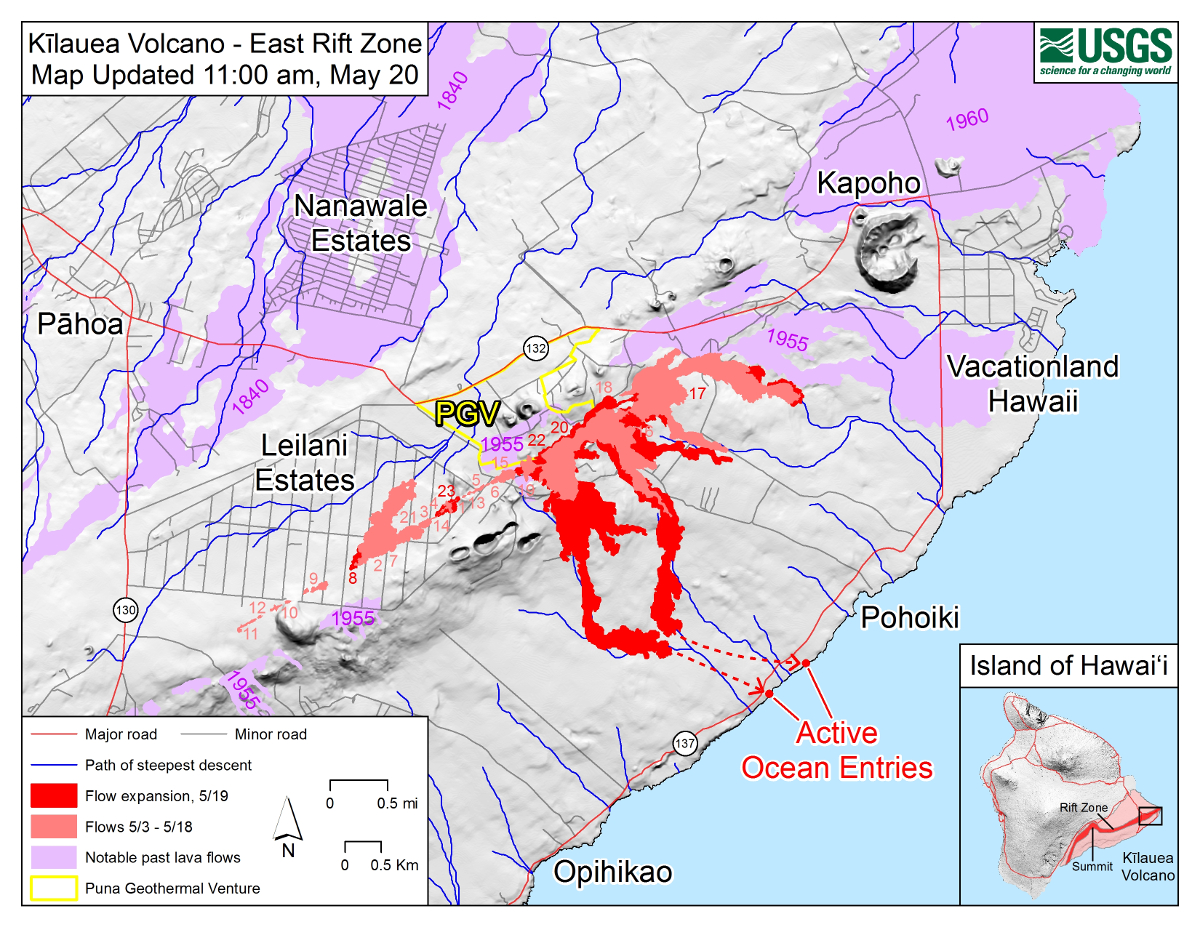
(USGS) Map as of 11:00 am HST, May 20. Shaded purple areas indicate lava flows erupted in 1840, 1955, 1960, and 2014-2015. Site of active ocean entry is shown with dots.
(BIVN) – As two lava flows continue to enter the ocean off Highway 137 near MacKenzie State Park, the Hawaiian Volcano Observatory reports that sulfur dioxide emission rates tripled down wind of the rift today.
Areas of Kamaili, Seaview, and Malama Ki have elevated levels, civil defense reports. “Take action necessary to limit further exposure,” officials said in a noon statement.
Due to hazardous conditions from lava and fires, the following policies are in effect:
- Highway 137 is closed between Kamaili Road and Pohoiki Road.
- Kamaili Road is closed to all thru traffic. No stopping, this is a high sulfur dioxide area.
- Everyone is asked to stay out of the area.
Due to the lava entry at the ocean, the following policies are in effect:
- Access to the area is prohibited due to the laze hazard.
- Stay away from any ocean plume. The plume travels with the wind and can change direction without warning.
- The U.S. Coast Guard is actively monitoring the area. Only permitted tour boats are allowed in the area.
The U.S. Coast Guard issued this media release on Sunday:
The Coast Guard is enforcing a Lava Entry Safety Zone for the navigable waters surrounding the Kilauea Volcano active lava flow entries into the Pacific Ocean on the southeast side of the Big Island, Hawai’i in the vicinity of the Mackenzie State Park Lower Puna region.
“For mariners without prior limited entry approval, the safety zone encompasses all waters extending 300 meters (984 feet) in all directions around the entry of the lava flow into the ocean,” said Lt. Cmdr. John Bannon, Coast Guard Sector Honolulu waterways management lead. “All waterway users should be aware of the hazardous conditions associated with such an event. Getting too close to the lava can result in serious injury or death.”
As long as lava enters the ocean, hazardous conditions are likely to occur with little to no warning and cannot be predicted. The Coast Guard took action to ensure public safety because of the aforementioned dangers.
According to Hawai’i Civil Defense, lava entering the ocean produces laze, which is formed when hot lava hits the ocean sending hydrochloric acid and steam with fine glass particles into the air. Laze health hazards include lung, eye and skin irritation.
In addition, ground deformation, seismic activity, newly formed lava delta or existing cliff collapses are all coastal hazards, including the potential for localized tsunamis along the coastline and out to sea. Based on a review of nearly 30 years of lava and ejection distance observations in the Hawaii Volcano Observatory records, a radius of 300 meters was determined as a reasonable minimum high hazard zone around a point of ocean entry.
Notification of any changes to the waterway safety zone enforcement will be provided to the public if the Safety Zone is changed or deactivated earlier than anticipated.
Enforcement of the Lower Puna safety zone began Sunday at 8 a.m.

by Big Island Video News12:33 pm
on at
STORY SUMMARY
PUNA, Hawaii - Hawaiian Volcano Observatory reported that sulfur dioxide emission rates tripled down wind of the rift today. Areas of Kamaili, Seaview, and Malama Ki have elevated levels.